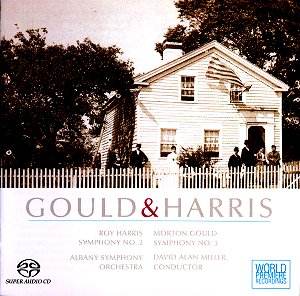This extremely welcome disc (dual CD and SACD) is bound to
command attention among the legion of Harris fans and the smaller band
intrigued by the concert music of Morton Gould.
Gould recorded as conductor with the Chicago Symphony.
His Miaskovsky 21 and Ives Symphony No. 1 (both RCA) were well regarded.
I know the first two Gould symphonies from tapes of ancient off-air
disc recordings. Neither is particularly striking and Gould's grounding
in Tin Pan Alley rather rocks the boat though both works have their
impact if played full-bloodedly. Turning to the Third Symphony this
is a big work heavy with foreboding and with the complexities of a new
world. There are bluesy excursions in the writing for the violins in
the second movement and some scatty Weill-like ructions in the movement
titled 'moderately fast with sardonic humour'. The finale exists in
two versions. The one used here is the original rather than the flamboyantly
upbeat replacement. Even so this carries the impress of Prokofiev and
the vituperative spit and grit of William Schuman without Schuman's
sense of irresistible progress. There are also unmistakable Harris vistas
here as in the section of the finale from 08.30 onwards.
Morton Gould's symphonic tally runs to:-
- Symphony No. 1 Victory Ode (1943)
- Symphony No. 2 Symphony on a Marching Tune (1944)
- Symphony No. 3 (1947)
- Symphony No. 4 for concert band West Point Symphony (1952)
The Harris Second Symphony flanks Harris's justly
celebrated Third which itself is buttressed on the other side by the
Fourth 'Folksong Symphony' (very much a cowboy choralfest). The Second,
like the First but unlike its illustrious successor, is in three movements.
It was written for Koussevitsky and completed in 1934 the year when
the Bostonians premiered the First Symphony. As it turned out Koussevitsky
deferred to his deputy, Richard Burgin when it came to premiering the
Second on 28 February 1936. Harris, an inveterate tinkerer, hacked and
cut the symphony. With his confidence in the work already in tatters
he decided not to attend the first performance. The critics were, as
expected, faint in their praise. The work was shelved and it took David
Alan Miller and Ray Bono to track down the score and restore the cuts
made by the composer. I think the work is unsatisfactory. Do not expect
to find the logical concision and emotive punch of the Third Symphony.
There are redeeming features. Harris's halting gawkiness, defiant raptus
and Gabrieli-like writing for brass are in evidence as is the Big
Country eloquence of symphonies 3, 5, 6 and 7. A novel feature is
that both the first movement and the finale play with the first four
notes of the fate motif from Beethoven's Fifth Symphony. In the case
of the finale the work carries some Sibelian edginess as well as the
germs of tragic motifs now familiar to us from the maturity of the Sixth
and Seventh symphonies.
Albany are an indispensable label continually in a
ferment of creativity with adventurous choices being made. Miller has
recorded Harris 8 and 9 for them. There are also many discs of George
Lloyd's orchestral music as well as that of Piston, Schuman and other
first-line Americans as well as fascinating characters such as Irwin
Bazelon, Edgar Stillman Kelley, Don Gillis, Arnold Rosner and many others.
Their three volumes (it may be four by now) of Eshpai I have hopes of
tackling if only I can track down review copies.
To sum up this disc: Two lost symphonies now found
and well advocated to us by Miller and the Albany orchestra. Neither
is unquestionably compelling but each is rich with unusual surprises
and with agreeable familiarities. Let us hope that there will be further
resurrections for we learn more and more of value about the cresting
wave of symphonism that gripped the US musical scene in the 1940s every
time an enterprise of this type comes to fruition.
Rob Barnett


